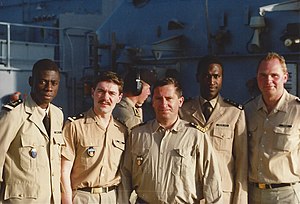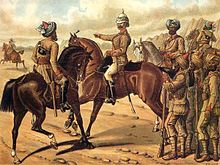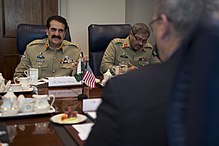Khaki

The colorkhaki(UK:/ˈkɑːki/,US:/ˈkæki/) is a light shade of tan with a slight yellowish tinge.
Khaki has been used by many armies around the world for uniforms and equipment, particularly in arid or desert regions, where it providescamouflagerelative to sandy or dusty terrain. It has been used as a color name in English since 1848 when it was introduced as a military uniform.[1]In Western fashion, it is a standard color forsmart casualdress trousers for civilians, which are also often calledkhakis.
In British English and some other Commonwealth usage,khakimay also refer to a shade of green known asolive drab.[2][3][4]
Etymology[edit]
Khakiis aloanwordfromUrduخاکی'soil-colored', which in turn comes fromPersianخاک[χɒːk]khāk'soil' +ی(adjectival attributive suffix); it came into English via theBritish Indian Army.[5][6]
Origin[edit]

Khaki was first worn as a uniform in theCorps of Guidesthat was raised in December 1846 byHenry Lawrence(1806–1857),[6]agent to the Governor-General for the North-West Frontier and stationed inLahore.Initially the border troops were dressed in their native costume, which consisted of a smock and white pajama trousers made of a coarse home-spun cotton, and a cotton turban, supplemented by a leather or padded cotton jacket for cold weather. In 1848, a khaki uniform was introduced.[7]Subsequently, all regiments serving in the region, whether British or Indian, had adopted khaki uniforms for active service and summer dress. The original khaki fabric was a closely twilled cloth oflinenorcotton.
Military use[edit]

The impracticality of traditional bright colors such as thered coat,especially for skirmishing, was recognised early in the 19th century.[8][9]A response to improved technologies such asaerial surveillanceandsmokeless powder,khaki could camouflage soldiers in the field of battle.[10][6]
Khaki-colored uniforms were used officially by British troops for the first time during the1868 Expedition to Abyssinia,when Indian troops traveled to Ethiopia.[11]Subsequently, theBritish Armyadopted khaki for colonial campaign dress and it was used in theMahdist War(1884–89) andSecond Boer War(1899–1902). These uniforms became known askhaki drill,versions of which are still part of theuniforms of the British Army.
During the Second Boer War, the British forces became known as Khakis because of their uniforms.[citation needed]After victory in the war, the government called an election, which became known as thekhaki election,a term used subsequently for elections called to exploit public approval of governments immediately after military victories.
TheUnited States Armyadopted khaki during theSpanish–American War(1898), replacing their traditional blue field uniforms. TheUnited States NavyandUnited States Marine Corpsfollowed suit, authorizing khaki field and work uniforms.

When khaki was adopted for the continental BritishService Dressin 1902, the shade chosen had a clearly darker and more green hue (see photo). This color was adopted with minor variations by all the British Empire armies. The 1902 US Army uniform regulations also adopted a similar shade for soldiers' winter service uniforms under the nameolive drab.This shade of brown-green remained in use by many countries throughout the two World Wars.
Use in civilian clothing[edit]
Following World War II, military-issue khaki-coloredchino clothtwill trousers became a common part of civilian clothing. Today, the termkhakisis sometimes used to refer to the style of trousers, properly called chinos, regardless of their color.
Tones of khaki[edit]
Light khaki[edit]
| Light Khaki | |
|---|---|
| Hex triplet | #F0E68C |
| sRGBB(r,g,b) | (240, 230, 140) |
| HSV(h,s,v) | (54°, 42%, 94%) |
| CIELChuv(L,C,h) | (90, 62, 80°) |
| Source | X11[12] |
| ISCC–NBS descriptor | Light greenish yellow |
| B:Normalized to [0–255] (byte) | |
At right is displayed the colorlight khaki(also called khaki tan or justtan).
Khaki[edit]
| Khaki (HTML/CSS) | |
|---|---|
| Hex triplet | #C3B091 |
| sRGBB(r,g,b) | (195, 176, 145) |
| HSV(h,s,v) | (37°, 26%, 76%) |
| CIELChuv(L,C,h) | (73, 28, 61°) |
| Source | HTML/CSS |
| ISCC–NBS descriptor | Grayish yellow |
| B:Normalized to [0–255] (byte) | |
This is theweb colorcalledkhakiinHTML/CSS.[citation needed]
The color shown at right matches the color designated askhakiin the 1930 bookA Dictionary of Color,the standard for color nomenclature before the introduction of computers.
Dark khaki[edit]
| Dark Khaki | |
|---|---|
| Hex triplet | #BDB76B |
| sRGBB(r,g,b) | (189, 183, 107) |
| HSV(h,s,v) | (56°, 43%, 74%) |
| CIELChuv(L,C,h) | (73, 52, 82°) |
| Source | X11 |
| ISCC–NBS descriptor | Moderate greenish yellow |
| B:Normalized to [0–255] (byte) | |
At right is displayed the web colordark khaki.[13]
It corresponds toDark Khakiin theX11 color names.
Khaki green[edit]
| Khaki green | |
|---|---|
| Hex triplet | #728639 |
| sRGBB(r,g,b) | (114, 134, 57) |
| HSV(h,s,v) | (76°, 57%, 53%) |
| CIELChuv(L,C,h) | (53, 48, 101°) |
| Source | wikimix |
| ISCC–NBS descriptor | Pale olive brown |
| B:Normalized to [0–255] (byte) | |
At right is displayed the colorkhaki green,sometimes called simplykhakiinCommonwealthcountries. It is more commonly calledolive greenorolive drab.
See also[edit]
References[edit]
- ^Maerz and PaulA Dictionary of ColorNew York:1930 McGraw-Hill Page 197; Color Sample of Khaki: Page 49 Plate 13 Color Sample J7
- ^"Khaki entry in Cambridge Dictionary".Cambridge Dictionary.Retrieved25 November2020.
- ^"Khaki definition and meaning | Collins English Dictionary".collinsdictionary.
- ^Sykes, Pandora."Wardrobe Mistress: how to tackle the khaki jacket".The Times.The Times (of London).Retrieved22 December2020.
- ^Dictionary Meaning:Khaki;TheFreeDictionary; Free Online Dictionary, Thesaurus, and Encyclopedia
- ^abcSt. Clair, Kassia (2016).The Secret Lives of Colour.London: John Murray. pp. 240–241.ISBN9781473630819.OCLC936144129.
- ^"Khaki Uniform 1848–49: First Introduction by Lumsden and Hodson",Journal of the Society for Army Historical Research,82 (Winter 2004) pp 341–347
- ^Williams, Cynric R. (1827).Hamel, the Obeah man(1st ed.). London: Hunt and Clarke. p. 279.Retrieved3 February2016."...A red-coat on one of these rocks will only be a mark for these rebels."
- ^"The Army".Blackwood's Edinburgh Magazine.60(370): 144."...scarlet is unmilitary, first, because it is tawdry; and secondly, as rendering the soldier, when isolated, an easier mark than a less glaring colour." (1846)
- ^Tynan, Jane (2013).British Army Uniform and the First World War: Men in Khaki.London: Palgrave MacMillan.
- ^Byron Farwell,Armies of the Raj,1989, page 75.
- ^Çelik, Tantek; Lilley, Chris; Baron, L. David; W3C; Baron, L. David (19 June 2018)."CSS Color Module Level 3".w3.org.Retrieved22 October2018.
{{cite web}}:CS1 maint: numeric names: authors list (link) - ^CSS3 Color Module,retrieved 2010-09-12
